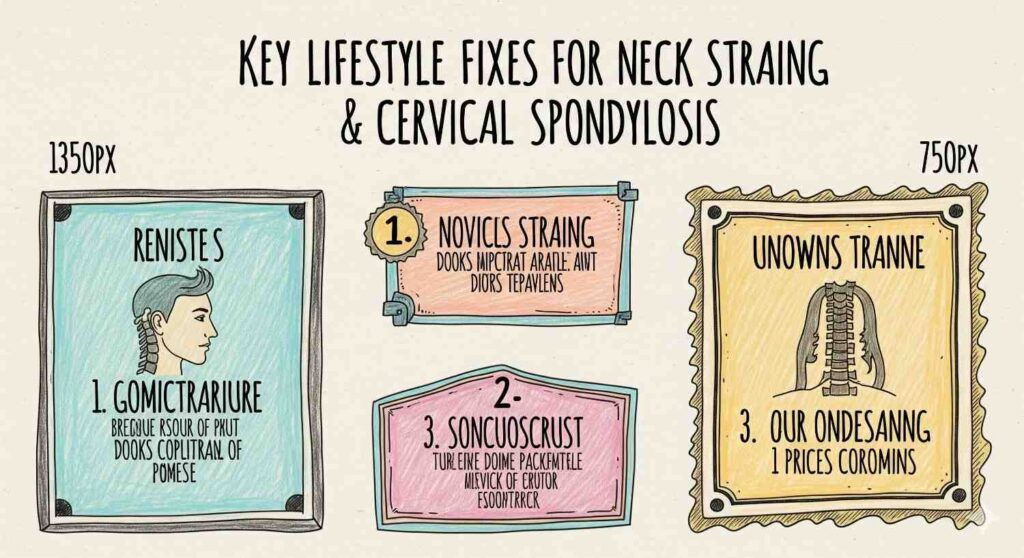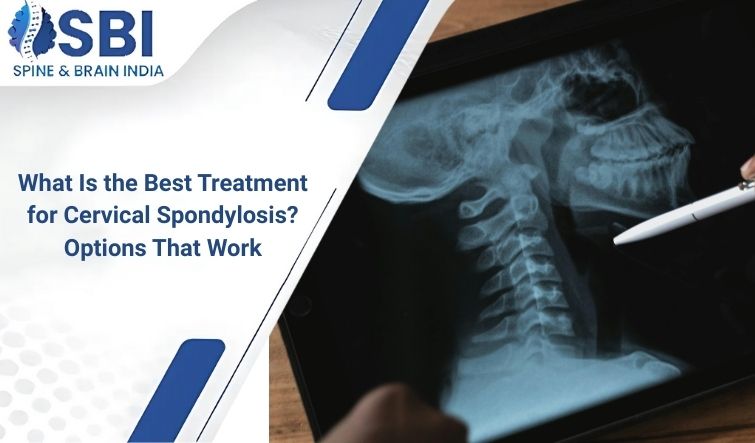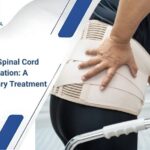If you’re living with the persistent discomfort of cervical spondylosis—the stiffness, the pain in your neck and shoulders, and perhaps the tingling in your arms and hands—you’ve likely been on a quest for relief. In this journey, a single question dominates your thoughts: what is the best treatment for cervical spondylosis? It’s a question that demands a straightforward answer, but the truth is, the “best” treatment is a highly personal journey. What works wonders for one person may not be the right choice for another, and the ideal solution depends entirely on the specific nature and severity of your condition.
Cervical spondylosis is a chronic, age-related condition that involves the wear and tear of the discs and joints in your neck. While it can’t be reversed, its symptoms can be managed, and in many cases, completely resolved. The goal is to find a treatment plan that not only works but provides a lasting solution to your pain and helps you regain your quality of life. This article will guide you through the effective options, from conservative measures to advanced surgical solutions, helping you understand what is the best treatment for cervical spondylosis for you.
Tier 1: The Foundation – Conservative Management
For the vast majority of individuals, the initial and most effective treatment for cervical spondylosis is a combination of conservative, non-surgical therapies. This is the starting point for almost everyone and often provides all the relief needed.

- Lifestyle Modifications: The First Step to Relief Before any medical intervention, a simple change in your daily habits can have a profound impact. Your posture and how you interact with your environment are key.
- Ergonomics: Your workspace is a primary source of neck strain. Ensure your computer monitor is at eye level, so you don’t have to look up or down. Your chair should provide good lumbar support, and your shoulders should be relaxed. This simple fix is a critical part of answering what is the best treatment for cervical spondylosis for many.
- Proper Posture: Avoid the “text neck” position where you are constantly looking down at your phone. Consciously keep your head aligned with your shoulders and spine, whether you’re standing, sitting, or walking.
- Weight Management: Excess body weight, particularly around the core, puts added stress on your entire spine. Maintaining a healthy weight can significantly reduce the load on your cervical discs and joints.
- Physical Therapy: A Cornerstone of Recovery Physical therapy (PT) is a cornerstone of conservative treatment and is often considered the most effective long-term solution for mild to moderate cases. A physical therapist will create a personalized program tailored to your specific needs.
- Strengthening Exercises: PT focuses on strengthening the muscles that support your neck, shoulders, and upper back. A strong support system reduces the burden on your cervical discs and vertebrae.
- Flexibility and Stretching: Gentle stretches can improve your neck’s range of motion and reduce stiffness. This is vital for combating the rigidity that often accompanies cervical spondylosis.
- Traction: In some cases, a physical therapist may use cervical traction to gently stretch the neck and create space between the vertebrae. This can help decompress the nerves and provide temporary relief.
- Medication Management Your doctor may recommend medications to help manage pain and inflammation, allowing you to participate more comfortably in physical therapy.
- Over-the-Counter Pain Relievers: Medications like ibuprofen and naproxen can help reduce pain and inflammation.
- Muscle Relaxants: For muscle spasms that are causing severe pain, a doctor may prescribe muscle relaxants.
- Nerve Pain Medication: If you are experiencing radiating pain, numbness, or tingling, a doctor may prescribe medications specifically designed to calm aggravated nerves.
- Home Remedies Simple remedies you can perform at home can also provide significant relief.
- Heat and Cold Therapy: Apply a cold pack to the painful area for 15-20 minutes to reduce inflammation, especially during a flare-up. Use a warm compress or heating pad to relax tight muscles and alleviate stiffness.
- Cervical Pillow: A supportive pillow that keeps your head and neck aligned with your spine can make a huge difference in preventing morning pain.
Searching for the Best Treatment for Cervical Spondylosis?
Explore proven treatment options with Dr. Arun Saroha, a leading spine specialist with 25+ years of experience. From non-surgical care to advanced surgical solutions, discover what works best for your condition.
Get Expert Treatment AdviceTier 2: Advanced Non-Surgical Options
When conservative management is not enough to provide lasting relief, more advanced non-surgical options may be considered.
- Cervical Epidural Steroid Injections: For patients with severe pain, especially that which radiates into the arms, a cervical epidural steroid injection can be highly effective.
- How it Works: A neurosurgeon or pain management specialist uses X-ray guidance to inject a steroid (a powerful anti-inflammatory) into the epidural space around the spinal cord and nerves. This can significantly reduce inflammation around the compressed nerves, providing months of relief. For many, this is a crucial step in answering what is the best treatment for cervical spondylosis, as it can break the cycle of pain and allow them to fully engage in physical therapy.
- How it Works: A neurosurgeon or pain management specialist uses X-ray guidance to inject a steroid (a powerful anti-inflammatory) into the epidural space around the spinal cord and nerves. This can significantly reduce inflammation around the compressed nerves, providing months of relief. For many, this is a crucial step in answering what is the best treatment for cervical spondylosis, as it can break the cycle of pain and allow them to fully engage in physical therapy.
- Facet Joint Injections: If the pain is primarily from the facet joints (the small joints at the back of the vertebrae), a facet joint injection can be a diagnostic and therapeutic tool.
- How it Works: A steroid is injected directly into the painful facet joint. If the pain subsides, it confirms the joint is the source of the pain, and the relief can be long-lasting.
Tier 3: Surgical Intervention – A Permanent Solution for Specific Cases
For a small percentage of individuals, cervical spondylosis progresses to a point where it causes severe, debilitating symptoms that do not respond to conservative or interventional therapies. These symptoms may include progressive numbness or weakness in the arms and legs or, most critically, a condition called cervical myelopathy (spinal cord compression), which can lead to problems with balance and coordination. In these cases, the most definitive and effective treatment is surgery. Here, surgery is not just the best option; it’s the only option that can provide a permanent, structural solution.
- When is Surgery the “Best” Treatment? Surgery is considered the best treatment for cervical spondylosis when there is:
- Persistent and severe pain that has not responded to conservative treatments for at least six months.
- Progressive neurological deficit, such as worsening numbness or weakness in the arms or legs.
- Evidence of cervical myelopathy (spinal cord compression), as this requires urgent intervention to prevent irreversible damage.
- Common Surgical Procedures: The goal of most cervical spondylosis surgeries is to decompress the nerves or spinal cord and/or stabilize the spine.
- Anterior Cervical Discectomy and Fusion (ACDF): This is one of the most common and successful procedures. The surgeon accesses the spine from the front of the neck, removes the damaged disc and any bone spurs, and then fuses the vertebrae together with a bone graft. This stabilizes the spine and permanently eliminates the source of nerve compression.
- Laminectomy/Laminoplasty: When the spinal cord is being compressed from the back (often due to thickened ligaments or bone spurs), a laminectomy can be performed. The surgeon removes the lamina (the bony arch on the back of the vertebra) to create more space for the spinal cord. A laminoplasty is a similar procedure where the lamina is hinged open rather than fully removed.
- Artificial Disc Replacement (ADR): For carefully selected candidates, an ADR may be an option instead of a fusion. The damaged disc is removed and replaced with an artificial disc. This preserves motion at the surgical level and can be a highly effective long-term solution.
Searching for the Best Treatment for Cervical Spondylosis?
Explore proven treatment options with Dr. Arun Saroha, a leading spine specialist with 25+ years of experience. From non-surgical care to advanced surgical solutions, discover what works best for your condition.
Get Expert Treatment AdviceChoosing the “Best” Treatment: A Personalized Approach
The true answer to what is the best treatment for cervical spondylosis is that it’s a collaborative decision. It should involve a thorough medical evaluation, including your symptoms, medical history, and diagnostic imaging (X-rays, MRI, CT scans). The best treatment is the one that is most appropriate for the specific stage and severity of your condition and aligns with your personal goals and lifestyle. It should always be a shared decision between you and your healthcare provider.
The “best” treatment for a mild case might be a combination of physical therapy and lifestyle changes. For a patient with severe, radiating pain, an injection may be the best short-term answer. And for someone with debilitating weakness from spinal cord compression, the most effective and lasting solution is surgery.
For a diagnosis and a treatment plan that is both accurate and tailored to your specific needs, it is crucial to consult with a highly experienced spine specialist. Dr. Arun Saroha is a distinguished neurosurgeon with vast experience in the diagnosis and treatment of complex spine disorders, from conservative management to advanced surgical interventions. His profound expertise in both minimally invasive and complex open surgical techniques ensures that he can recommend and perform what is the best treatment for cervical spondylosis for each individual patient, guiding them toward a life of greater comfort and mobility.
Frequently Asked Questions (FAQs)
Is surgery the only way to get permanent relief from cervical spondylosis?
No, surgery is not the only way to get permanent relief from cervical spondylosis. Many people find a permanent resolution of their symptoms through a combination of consistent lifestyle changes, proper posture, and a dedicated physical therapy program. Surgery is considered the “best” and most permanent solution only for those with severe symptoms or spinal cord compression.
Can I treat cervical spondylosis on my own with over-the-counter medication and stretches?
While over-the-counter medications and gentle stretches can provide temporary relief, it is not recommended to treat cervical spondylosis entirely on your own. It is essential to get a professional diagnosis and guidance from a specialist or a physical therapist to ensure you are doing the right exercises and not inadvertently causing more harm to your neck.
How long do I have to wait before considering surgery for cervical spondylosis?
A surgeon will typically not recommend surgery for cervical spondylosis until a patient has completed a comprehensive, conservative treatment plan for at least six months without significant improvement in their symptoms. However, if there are signs of spinal cord compression or progressive nerve damage, surgery may be recommended much sooner.
Is physical therapy a long-term commitment for cervical spondylosis?
Yes, physical therapy is often a long-term commitment for managing cervical spondylosis. While the initial supervised sessions may last for several weeks, the exercises and lifestyle habits learned are meant to be continued for the rest of your life to maintain your neck’s strength, flexibility, and overall health.
Are epidural steroid injections a one-time treatment for cervical spondylosis pain?
No, an epidural steroid injection is not a permanent solution, but it can provide significant, long-lasting relief from pain by reducing inflammation around the nerves. The effect can last for several months, and the injection can be repeated, but it is typically used as part of a broader treatment plan that includes physical therapy.
Does an artificial disc replacement for cervical spondylosis have any advantages over a spinal fusion?
Yes, an artificial disc replacement has a key advantage over a spinal fusion for cervical spondylosis in that it preserves the natural motion of the treated segment of the spine. This can potentially reduce the stress placed on the adjacent levels of the spine, which some studies suggest may lower the risk of future degenerative issues at those levels.
Searching for the Best Treatment for Cervical Spondylosis?
Explore proven treatment options with Dr. Arun Saroha, a leading spine specialist with 25+ years of experience. From non-surgical care to advanced surgical solutions, discover what works best for your condition.
Get Expert Treatment Advice









